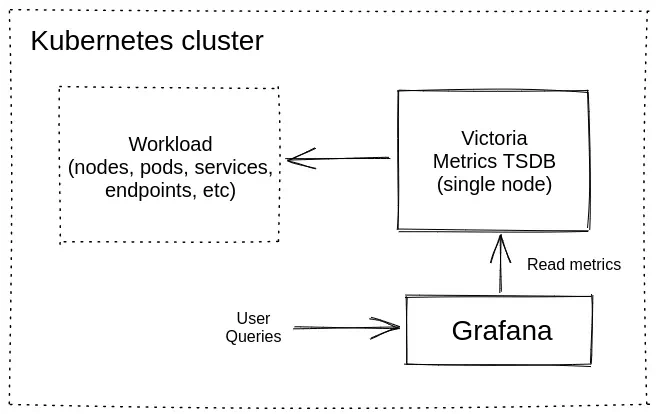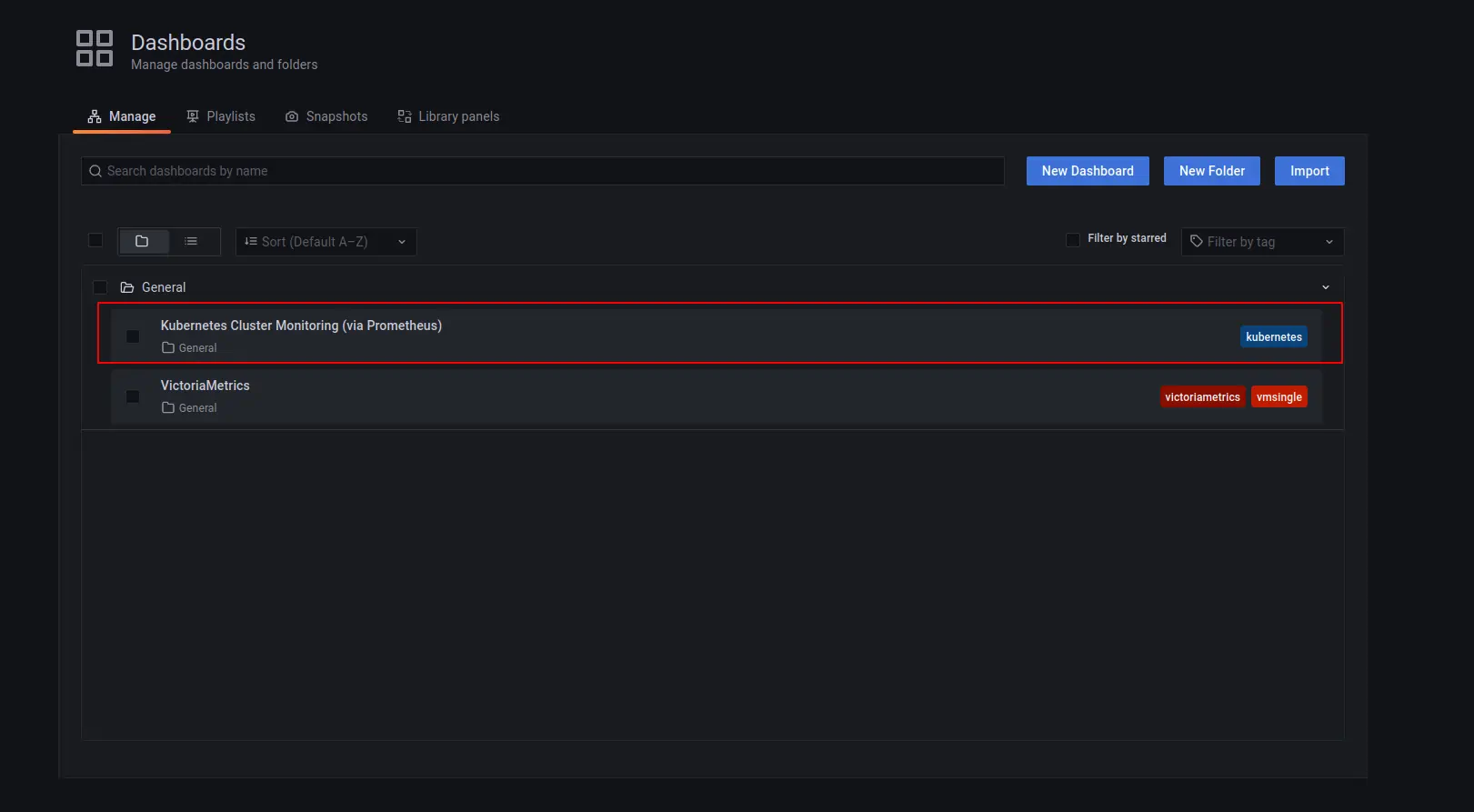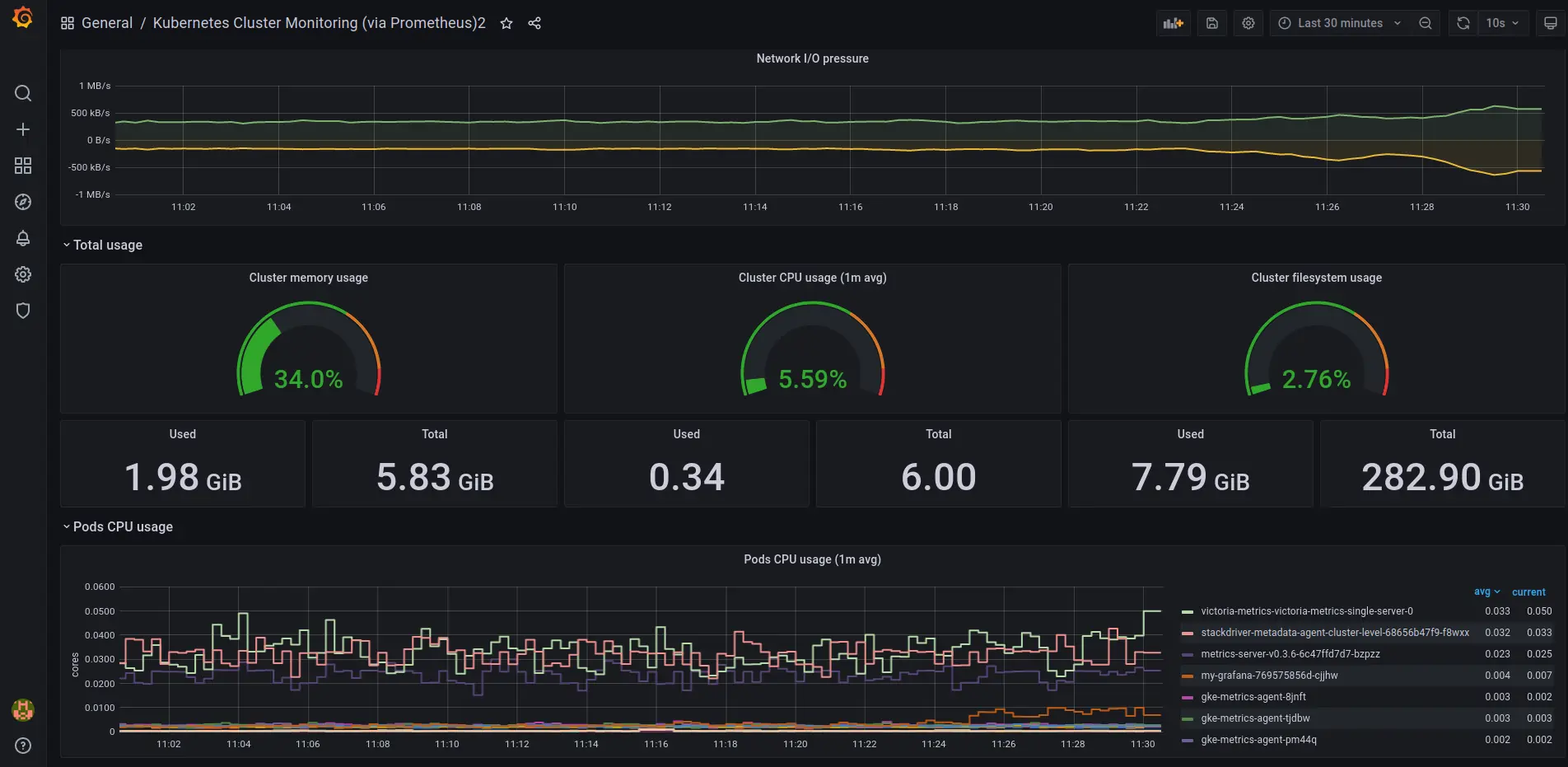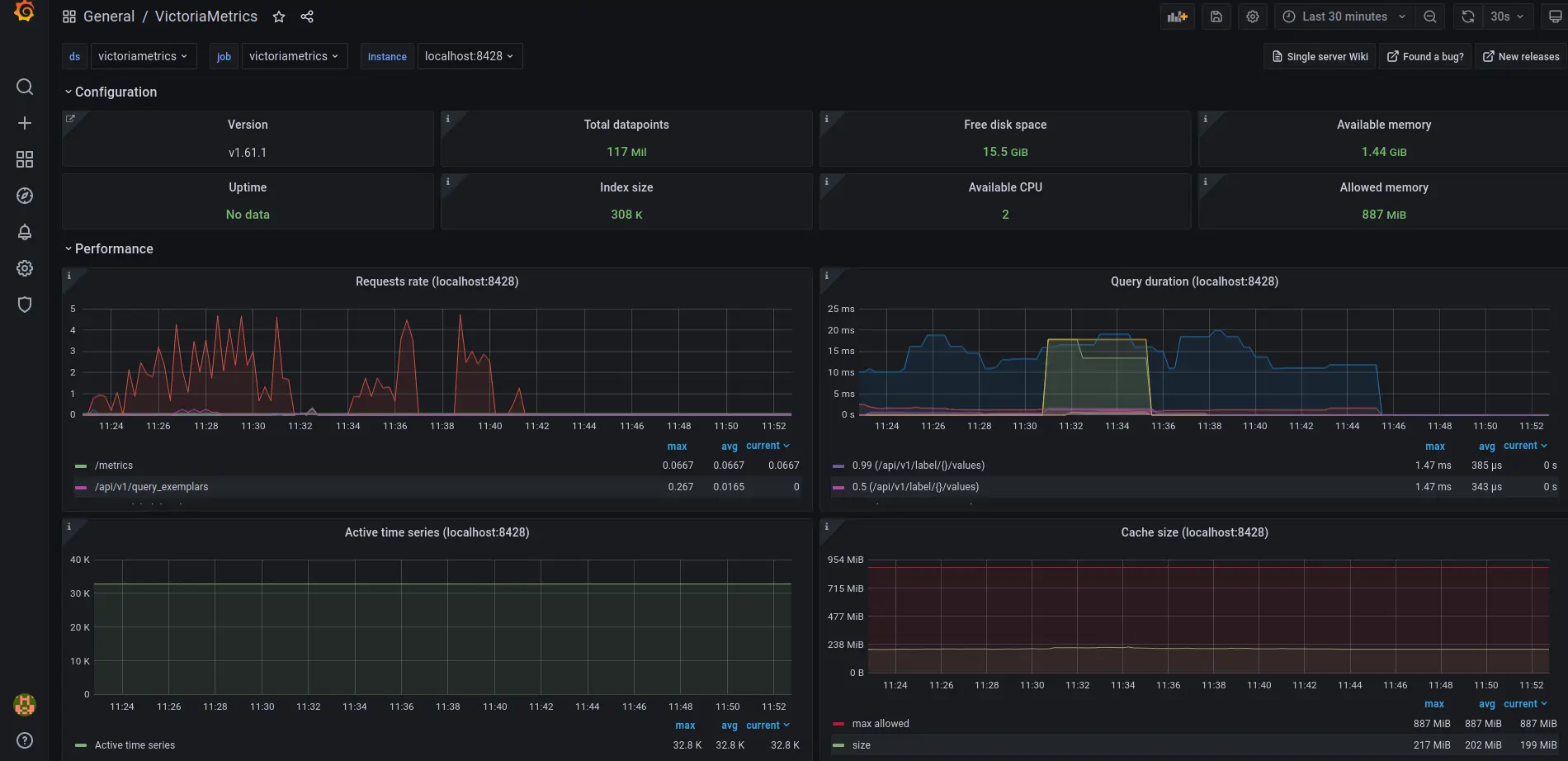The changes are based on SEO report and supposed to improve ranking and indexation by search engines by using prompt and unique titles and by updating unreachable links. It also updates links to have a simplified form and replaces relative links with absolute links according to https://docs.victoriametrics.com/#documentation --------- Co-authored-by: Roman Khavronenko <roman@victoriametrics.com>
12 KiB
| weight | title | menu | aliases | |||||||
|---|---|---|---|---|---|---|---|---|---|---|
| 2 | Kubernetes monitoring via VictoriaMetrics Single |
|
|
This guide covers:
- The setup of a VictoriaMetrics Single in Kubernetes via Helm charts
- How to scrape metrics from k8s components using service discovery
- How to visualize stored data
- How to store metrics in VictoriaMetrics tsdb
Precondition
We will use:
We use GKE cluster from GCP but this guide is also applied on any Kubernetes cluster. For example Amazon EKS.
1. VictoriaMetrics Helm repository
For this guide we will use Helm 3 but if you already use Helm 2 please see this https://github.com/VictoriaMetrics/helm-charts#for-helm-v2
You need to add the VictoriaMetrics Helm repository to install VictoriaMetrics components. We’re going to use VictoriaMetrics Single. You can do this by running the following command:
helm repo add vm https://victoriametrics.github.io/helm-charts/
Update Helm repositories:
helm repo update
To verify that everything is set up correctly you may run this command:
helm search repo vm/
The expected output is:
NAME CHART VERSION APP VERSION DESCRIPTION
vm/victoria-metrics-agent 0.7.20 v1.62.0 Victoria Metrics Agent - collects metrics from ...
vm/victoria-metrics-alert 0.3.34 v1.62.0 Victoria Metrics Alert - executes a list of giv...
vm/victoria-metrics-auth 0.2.23 1.62.0 Victoria Metrics Auth - is a simple auth proxy ...
vm/victoria-metrics-cluster 0.8.32 1.62.0 Victoria Metrics Cluster version - high-perform...
vm/victoria-metrics-k8s-stack 0.2.9 1.16.0 Kubernetes monitoring on VictoriaMetrics stack....
vm/victoria-metrics-operator 0.1.17 0.16.0 Victoria Metrics Operator
vm/victoria-metrics-single 0.7.5 1.62.0 Victoria Metrics Single version - high-performa...
2. Install VictoriaMetrics Single from Helm Chart
Run this command in your terminal:
helm install vmsingle vm/victoria-metrics-single -f https://docs.victoriametrics.com/guides/guide-vmsingle-values.yaml
Here is full file content guide-vmsingle-values.yaml
server:
scrape:
enabled: true
configMap: ""
config:
global:
scrape_interval: 15s
scrape_configs:
- job_name: victoriametrics
static_configs:
- targets: [ "localhost:8428" ]
- job_name: "kubernetes-apiservers"
kubernetes_sd_configs:
- role: endpoints
scheme: https
tls_config:
ca_file: /var/run/secrets/kubernetes.io/serviceaccount/ca.crt
insecure_skip_verify: true
bearer_token_file: /var/run/secrets/kubernetes.io/serviceaccount/token
relabel_configs:
- source_labels:
[
__meta_kubernetes_namespace,
__meta_kubernetes_service_name,
__meta_kubernetes_endpoint_port_name,
]
action: keep
regex: default;kubernetes;https
- job_name: "kubernetes-nodes"
scheme: https
tls_config:
ca_file: /var/run/secrets/kubernetes.io/serviceaccount/ca.crt
insecure_skip_verify: true
bearer_token_file: /var/run/secrets/kubernetes.io/serviceaccount/token
kubernetes_sd_configs:
- role: node
relabel_configs:
- action: labelmap
regex: __meta_kubernetes_node_label_(.+)
- target_label: __address__
replacement: kubernetes.default.svc:443
- source_labels: [ __meta_kubernetes_node_name ]
regex: (.+)
target_label: __metrics_path__
replacement: /api/v1/nodes/$1/proxy/metrics
- job_name: "kubernetes-nodes-cadvisor"
scheme: https
tls_config:
ca_file: /var/run/secrets/kubernetes.io/serviceaccount/ca.crt
insecure_skip_verify: true
bearer_token_file: /var/run/secrets/kubernetes.io/serviceaccount/token
kubernetes_sd_configs:
- role: node
relabel_configs:
- action: labelmap
regex: __meta_kubernetes_node_label_(.+)
- target_label: __address__
replacement: kubernetes.default.svc:443
- source_labels: [ __meta_kubernetes_node_name ]
regex: (.+)
target_label: __metrics_path__
replacement: /api/v1/nodes/$1/proxy/metrics/cadvisor
metric_relabel_configs:
- action: replace
source_labels: [pod]
regex: '(.+)'
target_label: pod_name
replacement: '${1}'
- action: replace
source_labels: [container]
regex: '(.+)'
target_label: container_name
replacement: '${1}'
- action: replace
target_label: name
replacement: k8s_stub
- action: replace
source_labels: [id]
regex: '^/system\.slice/(.+)\.service$'
target_label: systemd_service_name
replacement: '${1}'
- By running
helm install vmsingle vm/victoria-metrics-singlewe install VictoriaMetrics Single to default namespace inside your cluster - By adding
scrape: enable: truewe add and enable autodiscovery scraping from kubernetes cluster to VictoriaMetrics Single - On line 166 from https://docs.victoriametrics.com/guides/guide-vmsingle-values.yaml we added
metric_relabel_configssection that will help us to show Kubernetes metrics on Grafana dashboard.
As a result of the command you will see the following output:
NAME: victoria-metrics
LAST DEPLOYED: Fri Jun 25 12:06:13 2021
NAMESPACE: default
STATUS: deployed
REVISION: 1
TEST SUITE: None
NOTES:
The VictoriaMetrics write api can be accessed via port 8428 on the following DNS name from within your cluster:
vmsingle-victoria-metrics-single-server.default.svc.cluster.local
Metrics Ingestion:
Get the Victoria Metrics service URL by running these commands in the same shell:
export POD_NAME=$(kubectl get pods --namespace default -l "app=server" -o jsonpath="{.items[0].metadata.name}")
kubectl --namespace default port-forward $POD_NAME 8428
Write url inside the kubernetes cluster:
http://vmsingle-victoria-metrics-single-server.default.svc.cluster.local:8428/api/v1/write
Metrics Scrape:
Pull-based scrapes are enabled
Scrape config can be displayed by running this command::
kubectl get cm vmsingle-victoria-metrics-single-server-scrapeconfig -n default
The target’s information is accessible via api:
Inside cluster:
http://vmsingle-victoria-metrics-single-server.default.svc.cluster.local:8428/targets
Outside cluster:
You need to port-forward service (see instructions above) and call
http://<service-host-port>/targets
Read Data:
The following url can be used as the datasource url in Grafana::
http://vmsingle-victoria-metrics-single-server.default.svc.cluster.local:8428
For us it’s important to remember the url for the datasource (copy lines from output).
Verify that VictoriaMetrics pod is up and running by executing the following command:
kubectl get pods
The expected output is:
NAME READY STATUS RESTARTS AGE
vmsingle-victoria-metrics-single-server-0 1/1 Running 0 68s
3. Install and connect Grafana to VictoriaMetrics with Helm
Add the Grafana Helm repository.
helm repo add grafana https://grafana.github.io/helm-charts
helm repo update
By installing the Chart with the release name my-grafana, you add the VictoriaMetrics datasource with official dashboard and kubernetes dashboard:
cat <<EOF | helm install my-grafana grafana/grafana -f -
datasources:
datasources.yaml:
apiVersion: 1
datasources:
- name: victoriametrics
type: prometheus
orgId: 1
url: http://vmsingle-victoria-metrics-single-server.default.svc.cluster.local:8428
access: proxy
isDefault: true
updateIntervalSeconds: 10
editable: true
dashboardProviders:
dashboardproviders.yaml:
apiVersion: 1
providers:
- name: 'default'
orgId: 1
folder: ''
type: file
disableDeletion: true
editable: true
options:
path: /var/lib/grafana/dashboards/default
dashboards:
default:
victoriametrics:
gnetId: 10229
revision: 22
datasource: victoriametrics
kubernetes:
gnetId: 14205
revision: 1
datasource: victoriametrics
EOF
By running this command we:
- Install Grafana from Helm repository.
- Provision VictoriaMetrics datasource with the url from the output above which we copied before.
- Add this dashboard for VictoriaMetrics.
- Add this dashboard to see Kubernetes cluster metrics.
Check the output log in your terminal.
To see the password for Grafana admin user use the following command:
kubectl get secret --namespace default my-grafana -o jsonpath="{.data.admin-password}" | base64 --decode ; echo
Expose Grafana service on 127.0.0.1:3000:
export POD_NAME=$(kubectl get pods --namespace default -l "app.kubernetes.io/name=grafana,app.kubernetes.io/instance=my-grafana" -o jsonpath="{.items[0].metadata.name}")
kubectl --namespace default port-forward $POD_NAME 3000
Now Grafana should be accessible on the http://127.0.0.1:3000 address.
4. Check the obtained result in your browser
To check that VictoriaMetrics has collects metrics from the k8s cluster open in browser http://127.0.0.1:3000/dashboards and choose Kubernetes Cluster Monitoring (via Prometheus) dashboard. Use admin for login and password that you previously obtained from kubectl.
You will see something like this:
VictoriaMetrics dashboard also available to use:
5. Final thoughts
- We have set up TimeSeries Database for your k8s cluster.
- Collected metrics from all running pods,nodes, … and store them in VictoriaMetrics database.
- Visualize resources used in Kubernetes cluster by Grafana dashboards.



